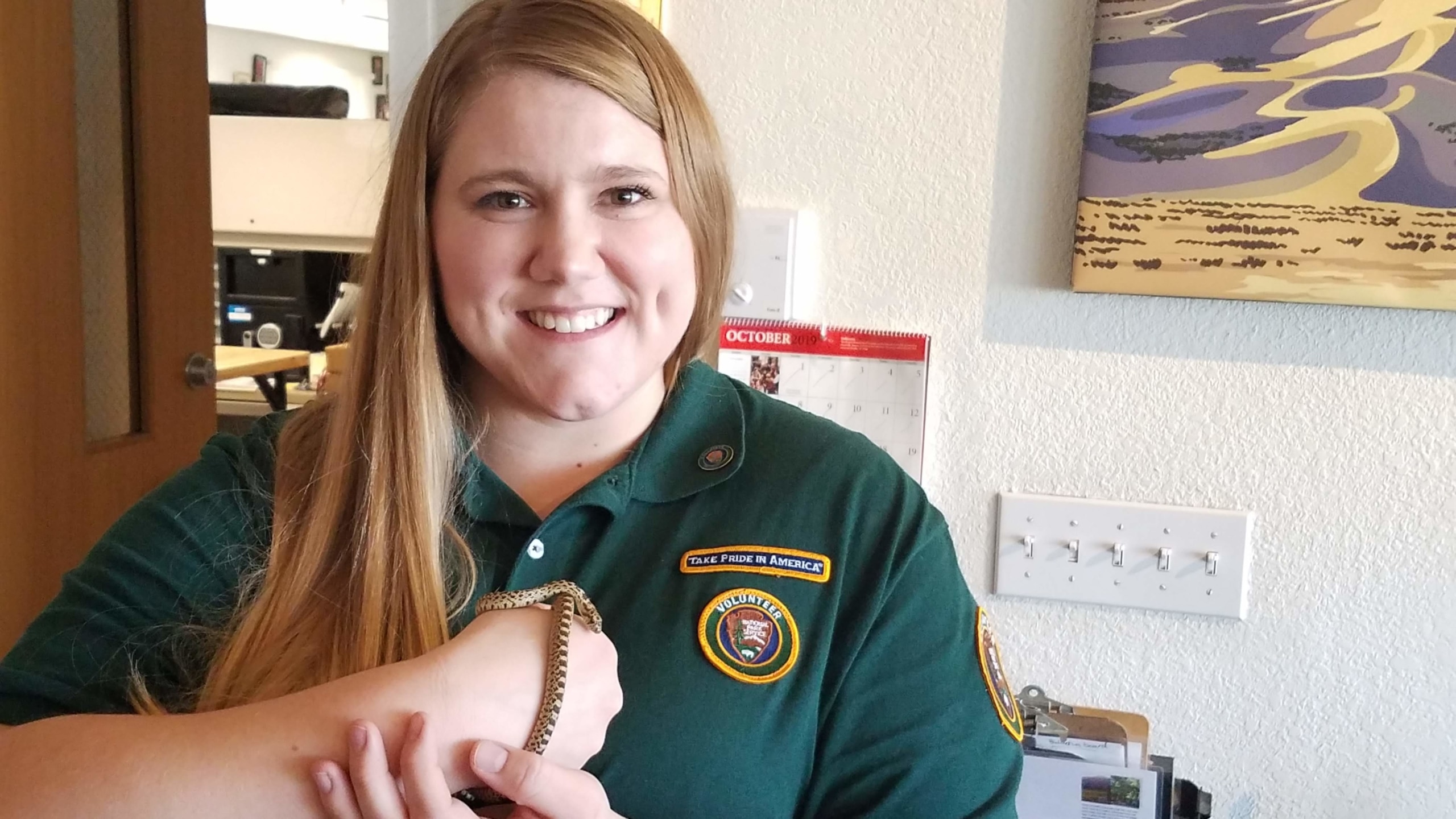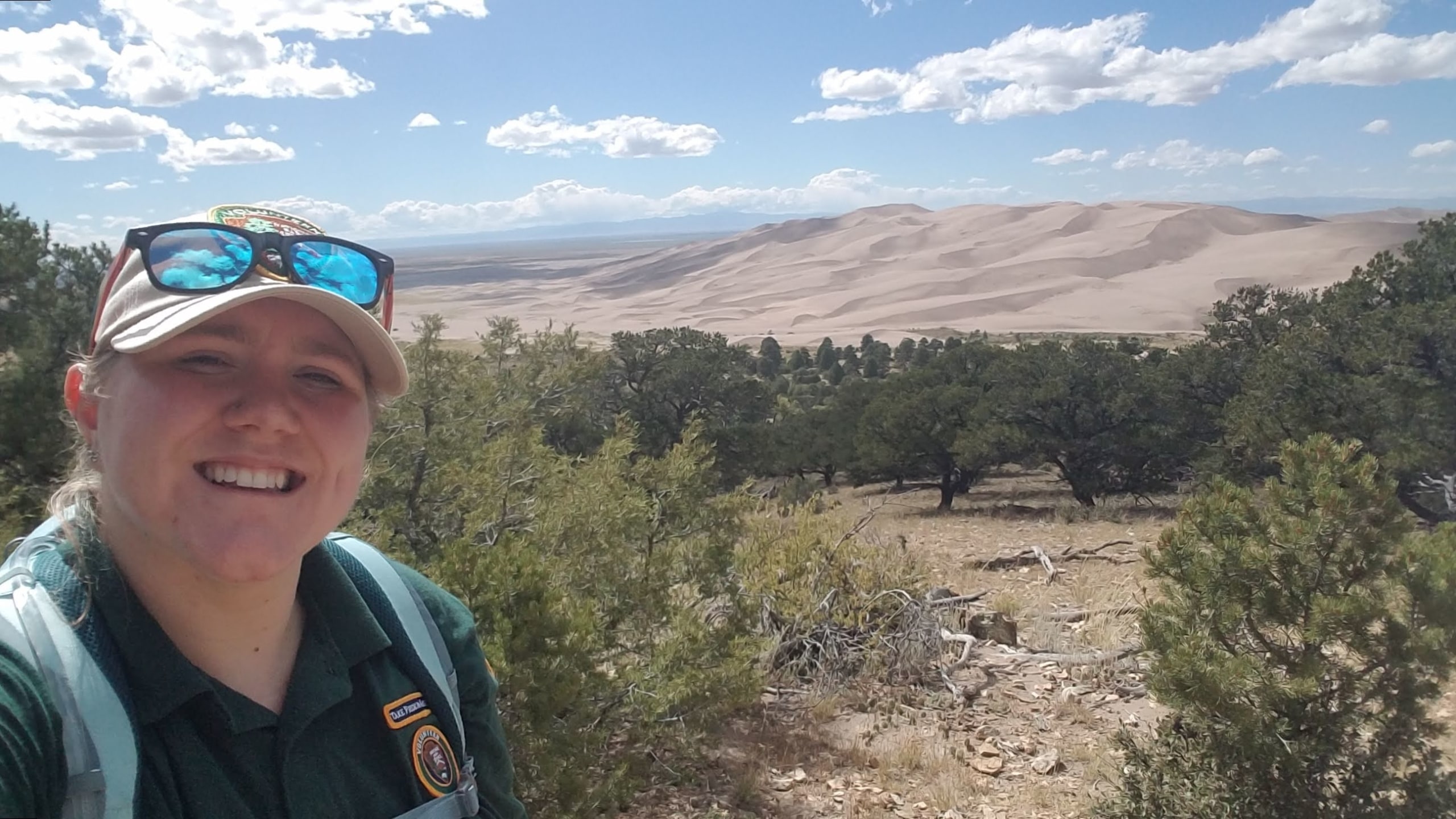By Sydni Dobson
This season, The Corps Network is featuring Corpsmember voices and stories of interns and “individual placement members.” Below, Holly Anderson shares her personal experience as an Individual Placement (IP) under Southwest Conservation Corps. Originally from the mountain community of Buena Vista, CO, Holly currently lives in Alamosa, CO and serves as the Interpretation and Visitor Services IP at the Great Sand Dunes National Park and Preserve. This is Holly’s third term as an Individual Placement intern.
 How did you learn about the program and what interested you in joining?
How did you learn about the program and what interested you in joining?
I was attending grad school at Fort Hays State University in Kansas, where I met my boyfriend. He ended up getting a job out near Alamosa as a teacher and brought me here. I was looking for new job opportunities that would hopefully get me into a state or federal agency, because that’s where I wanted to ultimately end up. There were times in grad school, where I’d get the question, “What do you want to do when you graduate?” It always came down to working in a state or federal agency.
My background is more biology, wildlife biology, and natural resources. So, this is kind of the perfect place for me to be right now. I was very happy to see that the Visitors Center was hiring. I know it’s a little different than strictly wildlife and natural resources, but it gives me a good insight on how the National Park Service works, all while doing it in a way that can impact others.
How many terms have you served as an IP?
This is actually my third term as an Individual Placement at this park. I started back in September 2019 and my first term ended in January. My second term started in February, but I ended up cutting that short because I got a position with the National Park Service during the summer as a Bio Tech. It was really good timing and a good opportunity, so I had to take it. Then this position came open, filling in for someone during the winter; I figured, even though I had done this Individual Placement work before, the scope of work is a little bit different this time around. Especially in COVID times. A lot of it’s more focused digitally, so that’s something that I’m still learning. It’s been valuable in that aspect.
What type of work are you doing in your current role?
I am still doing some customer service. I work the front desk, answer customers’ questions and direct them around the park. They also want me to help work on some apps that they’re developing. The Department of Interior is coming out with an app, so they’re having me work with one of the Rangers on developing content for the Great Sand Dunes National Park.
I’m currently working on updating a summer archaeology program that the park makes for younger visitors. This is new for me; I haven’t done any kind of curriculum development like this before. An idea I’m working on right now is to create interpretative materials that I could give to the future seasonal rangers coming in to learn more information about natural resources in the park.
“One of my goals for this internship is to create interpretative programs that families can use to self-guide through the park. Hopefully, these interpretative programs will be put on the website or maybe developed into the app.”
Describe an average day in your role.
It’s definitely a little bit different in COVID times. I come into the office and begin cleaning and sanitizing all areas. The opening procedures consist of getting the desk ready, putting the flag up, and stamping out passport stamps for the visitors. Another thing is doing the morning report, giving an overview of what to expect in the day and sending it to the Rangers in the park. Yet, we’re not at the desk for hours at a time, we break it up into individual slots, so that we can have time to work on projects too.
Speaking of projects, do you have any projects that you’ve enjoyed working on the most?
One of the projects that I was working on with one of my Rangers this spring consisted of a new night sky book that is specific to Great Sand Dunes. This book was more suited for a Junior Ranger, but it was geared towards exploring the park at night. We’re a certified International Dark Sky Park and we have really dark skies. It provides interesting opportunities for families to explore out here. We created an activity book and came up with the activities that we wanted to do – we basically designed it. There isn’t a set print date for that yet.
What is your favorite part about the program?
You know aside from learning all of these cool things about the National Park Service and Great Sand Dunes, it’s getting to meet different people from around the world. They come from all over and are here to see the same beautiful things. People really value these places and it’s really cool that its worldwide, and not just for the United States.

Have you gained any new skills or certifications?
I’ve definitely gained a lot of new skills. I’ve worked on my customer service skills and in recent times I’ve worked on digital content, something that’s totally out of my wheelhouse. Another thing too: I forgot to mention that in my earlier terms, I was doing interpretative programs. I actually developed and researched what I wanted to do to these programs about and then presented them. Last fall is when I did my first program. Just learning how to capture and relate to an audience is different when you’re not used to interpretative speaking and writing.
Could you elaborate more on what interpretative speaking and writing is?
Like a guide in a museum that may interpret what is being portrayed in a painting. Interpretation (especially in parks) is a guide that helps lead audiences to underlying meanings of a physical resource. This in turn helps an audience understand their relationship to and potential impacts they can have on the resource, thus provoking connection to the resource.
How often were you doing your interpretative programs?
I was doing them Friday, Saturday, and Sunday. Those are typically our busy days.
My first program, which was more about species and their adaptations, was about a 15-20-minute program that I’d do on the back porch and would bring out props, so that they could visually see what I’m talking about. My winter ecology program was half an hour, and I actually did a hike outside. We could be walking along the trail and I might see a plant, then tell people about this species and what it does in the wintertime.
Have you learned anything new about yourself?
I can be very adaptive. I’ve learned that I am able to take what other people go through or teach me, and I can make a beautiful product out of it. I’m actually really proud of my interpretative program; again, it was something that was completely out of my wheelhouse. I’ve never done that before. I sat down with one of the Rangers when he went over general stuff about interpretative programs and what handles to use, then I took that and ran with it. I created a program and I’m really proud of it. I’m also giving a program about things that I’m really interested in too.
What are your plans following this program?
Following this program, hopefully I will get another position with the National Park Service. Beyond that, I don’t really know.
What are your long-term goals?
A permanent job with natural resources or wildlife biology. If possible, more of a wildlife position than anything. Ideally, a Wildlife Biologist or Natural Resource Manager.

What advice would you give others considering a program like this?
I would advise people to go for it! Even if there are some aspects that might not seem super interesting to you, you might meet some amazing people along the way that open up even more doors and opportunities. I don’t regret any of my terms. I’ve learned a lot and met a lot of great people. I learned things about myself and it felt like a really well-rounded experience. The first two internships have definitely felt that way, and I’m sure I’ll get the same with this one as well.
Do you have anything else that you’d like to mention?
I would like to think that this program was one of the key components of me becoming a Bio Tech for the National Park Service. In this position, they allowed me to actually present some of my research in an employee meeting so that the Park Biologist and our Resource Management division could see the type of research that I’m capable of doing. I wouldn’t been able to do that if I wasn’t a part of this program. They opened up different opportunities for me to interact with different branches. That was really neat!





































































